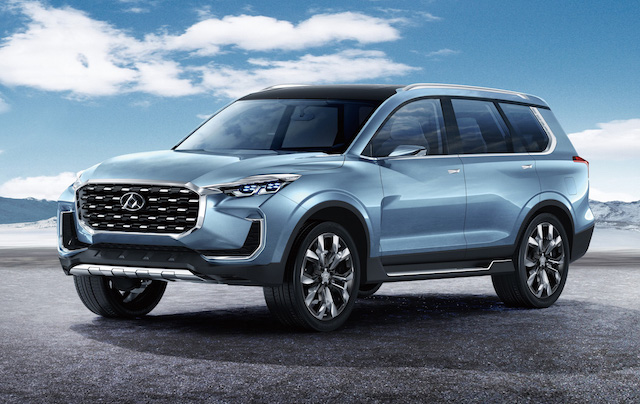
Chinese badge LDV is to grow its line-up of vehicles in New Zealand from next year, adding workhorse utes and a sports utility vehicle to its range of vans.
The utes have been benchmarked against the best-selling Ford Ranger and will be available in two-wheel and four-wheel-drive, with double-cab, single-cab and space-cab configurations.
The SUV is code-named the D90 project (top) and was shown at the recent Beijing motor show. It is said to be slightly bigger than the Toyota Land Cruiser 200 and is expected to land at the same time as the utes.
LDV (Leyland DAF Vehicles) has been all about multi-purpose vans since it set up in New Zealand in 2013. The G10 is a cargo van/people-mover starting in price at $25,990; the V80 is a cargo van/minibus, either in short- or long-wheelbase and priced from $32,190.
Tourist outfit Kea Campers has since bought 100 V80s to fit out. “We reckon we can get 15 per cent of the motorhomes market,” says LDV marketing manager Warren Willmot.
South Island bus company Ritchies has 46 vans. Courier companies are on LDV books. So far this year LDV has sold upwards of 260 vans for a 2 per cent share of the light-commercial segment. In April, it registered 71, or upwards of 15 per cent of the month’s 463 van sales.

“We’re kind of a challenger brand that’s come out of nowhere,” said Willmot. “The brand has history but really we are starting from scratch. To me it’s exciting because we get the chance to create our own identity here.”
So who and what is LDV? It’s one of four companies spun off from the insolvency in the early 1990s of a joint truck- and van-making venture between Dutch outfit DAF and Leyland, a division of Britain’s Rover Group.
LDV was making vans at its plant in Birmingham until it went broke in 2005. It was bought by a US investment company and sold some months later to Russia’s automotive GAZ Group.
The Russians couldn’t make a go of it and production at Birmingham was halted late in 2008. LDV than went into receivership. In 2010, China’s Shanghai Automotive Industry Coorporation (SAIC) bought its assets. SAIC is owned by the Chinese government and is the largest automotive operation in China.
The list of components in the G10 and V80 vans reads like an automotive who’s who: VM Motori, Delphi, Lear Corp, UAES, Valeo, Bosch, Continental, Tenneco, Sachs, Mira, ZF, Lotus … all suppliers to big-name car companies. “China makes the body panels and glass,” says Willmot.
LDV’s head office is in Taupo, along with its fitment centre and $7 million worth of parts. It’s dead-set on providing unparalleled service to customers, via its 17 nationwide dealers and growing service centres. One idea being explored is a late-night service centre for courier vans.
“We will pull apart new vehicles to keep our customers on the road,” says Willmot. “We can dispatch a new van to a customer inside 72 hours. That includes custom fitting it – even down to signwriting.” NZ accessory companies LDV uses include BestBars, Jemco, Unihold, Jackson Enterprises.
The G10 van comes with either a 105kW/200Nm 2.4-litre petrol engine mated to a five-speed manual gearbox, or a 165kW/330Nm 2.0-litre turbocharged petrol unit with a six-speed auto. The G10 seven-seater people-mover uses the boosted 2.0-litre drivetrain.
The V80 van/minibus is powered by a 2.5-litre turbo-diesel unit generating 100kW/330Nm with either a five-speed manual or six-speed auto.

